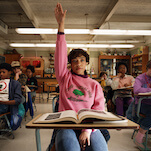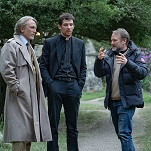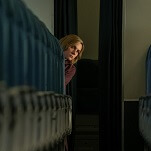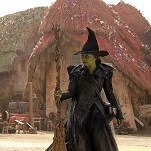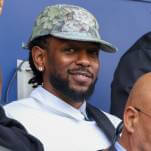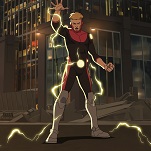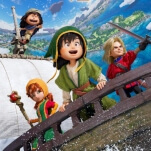Jeff Smith is one of independent comics' greatest success stories. Since its 1991 debut, his quirky, charming, self-published fantasy series Bone has evolved from an obscure cult hit into a cottage industry, published in 13 languages around the world. The epic story of three blobby, marshmallow-like creatures called "Bones" lost in a richly detailed world of hideous monsters and cute Disney-esque creatures, has won Smith dozens of awards—including, most recently, his sixth Harvey for Best Cartoonist. Smith put the Bone comic book on hiatus in 1999 to write, direct, and produce a theatrical animated adaptation planned for release this year. That film is still in development. Meanwhile, Bone returns this month, and Smith's company, Cartoon Books, is publishing its first non-Bone-related book, Linda Medley's fairy-tale-inspired Castle Waiting. Also in the works: a Bone prequel miniseries, Rose, written by Smith and illustrated by Ballads And Sagas artist Charles Vess. Smith recently spoke to The Onion A.V. Club about his history and Hollywood physics.
O: Have you considered publishing those early strips?
JS: I did collect them once. I put them in a little book when I was still in school, and I sold those around campus. I went to a printer, published it, and physically carried it around to all the different bookstores in Columbus. I sold 2,000 of them, and I'd only printed 2,500. But, boy, I can't stand looking at them now. I look back at them and they're just horrible. They're so… so… I have no desire to print them again at all.
O: What was your major at OSU?
JS: I never graduated, but I was kind of floating between journalism and art, because neither one wanted to claim me, as a cartoonist. Cartooning is some kind of bastard child of art and journalism.
O: When you left college, you helped found the Character Builders animation studio. Did you ever consider using the studio to independently animate Bone?
JS: I wondered if I could do an independent Bone thing, a short or something. It was pretty vague, I was young, and I didn't know what I wanted to do with the story or my characters. But as I got into the animation, as I learned more about the business, I learned that you need a lot of people to do anything animated—even a short, let alone a feature film. And you need a lot of money. So you need to convince a bunch of people to do this idea, to let you be the director, and to give you millions of dollars, and I started to think, "I don't know how feasible that is. It might make more sense to do it in print." Which was my original childhood love anyway, stuff like Peanuts and Doonesbury. So I started to look into going back into print cartooning, and I discovered The Tick, by Ben Edlund, which was a self-published comic book. That led me into comic-book stores. I had no idea that there were stores all over the world that sold comic books, and that there was a distribution process where you could set up your own label and get your books on the shelves. Once I did that, I could suddenly do the world of Bone, and I discovered this canvas that was perfect for telling it. It pulled me away from animation instantly.
O: At one point, you did intend to publish Bone as a mainstream newspaper comic strip, right?
JS: That was what I originally wanted, yes. The syndicates were smart enough to see that it didn't belong there. I spent a couple of years developing it, first with Tribune Media Services and then with King Features, but in the end it just didn't fly for a number of reasons. Mostly it wasn't funny enough. Like I said, it didn't belong in a comic strip. It's this fantasy world and an ongoing adventure, and a continuity strip today just isn't the same nowadays as it was when you had stuff like Flash Gordon and The Phantom.
O: When you did the first issue of Bone, how much of the overall story had you planned out?
JS: I thought I had a pretty good idea, and I did. I knew the ending, and I had a large, broad outline all set up. I made sure I wrote the ending, and I wrote the last page before I sat down and drew the first page.
O: How much spontaneity goes into the individual issues?
JS: A huge amount. That big giant broad plan is a wide road that I can wander all over. I find that the best moments come completely unexpectedly. I'm probably best known in comics for doing this segment called "The Great Cow Race," which is Gran'ma Ben racing, on foot, against all these cows. It's a really ridiculous, stupid thing, and it was not in the big outline at all. Gran'ma Ben was just this little, crazy old lady who raced cows. I thought that was sort of an off-the-top, Far Side-type joke. She's just weird. But then I started getting letters from readers saying, "Oh, I can't wait to see Gran'ma race the cows! I can't wait for the big cow race!" And I thought, "Oh, my gosh, I've created this expectation!" I could see in the story that I was sort of pulling toward it. The readers knew I was going toward it and I didn't. So eventually I had to belly up to the bar and put a cow race in the story. It turned out really well, and I fooled everyone.
O: Did you deliberately start with a funny story to draw people in and then shift tones once you had an audience, or have your intentions for Bone evolved over the last decade?
JS: That was actually very intentional. Even now, when we're working on the movie and we're working on scripts, I have to keep reminding everyone that you don't just jump to the fantasy. I think people have a little wall they throw up real quick if they see swords and sorcery. There's some really schlocky swords and sorcery out there, some schlocky fantasy. Even if a new TV show comes on and it's really good, and everybody's trying to get you sucked in, you don't want to watch it at first. You're like, "I don't have time to get into one more big thing. I don't want to have to watch that new TV show every week." It's the same thing with comics or fantasy. If I'd started Bone and said, "This is going to be a giant epic," people would be like, "Do I really want to get into that?" So I intentionally backed up and said, "I'll start with just the Bones, with simple Disney- and Uncle Scrooge-type adventures. We'll just proceed and let the characters fall into the adventure, just the way you fall into your adventures in real life.
O: How has the writing process changed for you as the plot has gotten more complex?
JS: Well, it's become more difficult. I have so many balls in the air that I have to constantly go back, reread, and say, "Ooop, I almost forgot about that one; gotta tie that up." That was one of the main reasons I took the break, even more than working on the movie. It just all kind of came together at the same time. I'd reached this point at the end of Act Two where I'd pulled all these threads together and it was something. It's a really big story, and I'd had no idea how big the story had gotten. Even I still look at Bone and think of it as a pretty simple little story, but it's massively complicated. I needed to step back from it for just a second, because that constant deadline of putting that book out every two months… You get to a point where you don't have time to think. That can be good, because sometimes when you don't have time to think you get some unexpected flow-of-consciousness stuff in there, but I needed to step back, reassess the whole story, and make sure it's on track the way everything's going.
O: The story has gotten more sophisticated, but some people probably still look at the simply drawn characters and the slapstick humor and assume it's a children's comic. Do you write it for any particular age group?
JS: I'm not sure. I think I write it for me. I know that might sound like a cliché, but I'm pretty sure there are other people like me who are adults… I'm 40 years old, and I still love watching Bugs Bunny slap the bull on the nose. I still watch those cartoons, and yet I also enjoy reading books about science, or the current fiction. I think the audience is truly all ages: I don't put anything in there that kids can't see, or shouldn't see, but I have to keep it interesting for me as an adult. I'm not sure who the audience is; I'm just glad they're reading it.
O: Your love of cartoons shows in your sense of comic timing.
JS: Oh, yeah. I'm not sure exactly how it all works, of course. I do know that I look at the world of Bone as one that's in motion. I don't think of it as a separated-out, drawn-frame-by-frame comic. I think the characters are really moving. When I want to set the timing up, I try to make it look like the frames are just little boxes up above that we're looking through into the world, and they just have to move. So the timing has to be the same comic timing you would have comic actors use. It's not funny if it doesn't snap, you know?
O: The motif of a highly detailed background and iconic, cartoony characters is common in Japanese and independent American comics, but it's not seen nearly as much in the mainstream. How did you arrive at the style?
JS: It definitely wasn't conscious. I think it was because the comics I loved were Tintin, which is a little round-headed boy with a little swoop of hair, and totally realistic backgrounds, with absolutely authentic detail in every background. Uncle Scrooge, by Carl Barks. This duck wearing spats and a top hat dives into his money bin, and every single coin is lovingly rendered. Or the bulldozer he uses to move the money around: Every nut and bolt is perfect and real. I actually think that kind of reality in the backgrounds adds to the believability of the comic as a whole.
O: Scott McCloud's Understanding Comics talks a lot about the reasoning behind that style. Did you feel a spark of recognition when you read it?
JS: Exactly. My whole take on Understanding Comics was like, "Wow, I kind of knew all this stuff, but this is like pulling away the curtain when I could just see the shapes through it." I enjoyed Understanding Comics quite a bit.
O: Some press releases from 1999 indicated that you were taking two years off for the Bone movie, but the current reports make it look like bringing the comic back this year was the plan all along.
JS: I've found that in Hollywood there is no "plan all along." They don't operate under the same rules of physics as we do. I think we were a little optimistic: We thought that, because Bone was so fleshed out, our development time would be really short, like six months or so. Instead, it's turned out to be a fairly normal development time of two years. But things are going really well, and we're hoping to put the movie out in 2002. But I didn't want to take any more time from my real field, which is comic books.
O: Now that you're back to doing the comic book, have you changed your mind about directing the movie yourself?
JS: I won't do the Bone comic once I start directing full-time.
O: The comic will go back on hiatus? When?
JS: I have a foggy timeline. It'll be around September or October so I can put out a couple of issues of Bone. I'm trying to balance it. I don't know. The movie could take a longer or shorter amount of time. It's hard to say.
O: What's the sticking point with the movie? Why the delay in production?
JS: Nothing, really, just the normal course of putting it together. We're working on the script. I just turned in a draft before Christmas, and that got the go-ahead to go to the next level. So now we're doing a rewrite that's happening right now. When that's done, hopefully we start.
O: How has the plot of the movie evolved with the rewrites?
JS: Now it's looking like it's going to follow closer to the comic than my first draft actually did, and go from the beginning through the "Dragonslayer" storyline, where Phoney Bone whips up the villagers' fears and superstitions about dragons for his own benefit. Sort of a McCarthy-era thing, where anyone who doesn't agree with Phoney gets labeled a dragon sympathizer. I think that's where we're going to take the story. I'm really happy with the direction of it right now.
O: Have you considered voices at all?
JS: No, I haven't. I'm terrified of that part. [Laughs.]
O: What if you could get anyone you wanted?
JS: Just a fantasy wish list? Okay, for Fone Bone, Tim Robbins. He's such a great actor, but all his acting comes from inside. Maybe Danny DeVito for Phoney Bone. Smiley Bone? I'm not sure. Bill Murray might not be bad. A really good suggestion somebody made to me was for the dragon: Tom Waits.
O: What about Gran'ma Ben and Lucius? Thorn?
JS: I just can't picture it. I'm terrified.
O: Are you a big Moby Dick fan? Is that how it keeps finding its way into Bone?
JS: Oh, yeah, I'm a huge Moby Dick fan. And you don't want me to talk about it. [Laughs.]
O: Are the running gags, where Fone Bone talks about Moby Dick and everyone falls asleep, taken from personal experience?
JS: Oh, yes. Sigh.
O: Is this upcoming story arc going to be the end of the Bone series?
JS: Yes.
O: What will you do after that?
JS: I don't know. It'll take me between three and five years to do the last three large books, and I can't think past that. I do have another project coming up with Paul Pope. He's one of my dearest friends in comics and one of the best cartoonists working today, I think. He's known for doing these oversized books, and we're going to do one together. It's going to be called Big Big, and we're each going to do a self-contained 40-page science-fiction story in it.
O: Have you started work on it yet?
JS: We're still talking. We're pretty much committed to the idea, but we're not sure what the plan is. We had talked about 2001, but we're still in the planning stages. But it's fun. That's something I want to do before Bone ends, so I can do stuff like that after it ends.
O: Have you ever considered doing a comic about Boneville itself?
JS: Not really. Maybe in the beginning I did, but once I started getting feedback in the letters… That's the interesting thing about doing comic books that come out as a serial: Every time an issue comes out, there's this communal discussion of the issue on the Internet and in the letters, and it's a very different way of progressing in your story than just doing a novel and putting it out. I realized that everybody had their own vision of what Boneville looked like. It was their own little world that they had created, whether it was Duckburg or some fantasy place. I could never draw a Boneville that would match everybody's ideas, and maybe I shouldn't. Maybe I should just let everybody make up Boneville, and Boneville will just be something inside everybody. I decided, "Why don't I just leave it at that?"
O: People often cite Walt Kelly's Pogo as one of your primary inspirations, partially because Fone Bone looks something like Pogo. Do you think the connections run deeper than that?
JS: I think on a slightly deeper level, I learned a lot from Walt Kelly about giving characters personalities, about making them personalities that talk to each other. I learned a lot from reading Pogo about how to make Albert sound like Albert, how to make Churchy sound like Churchy, how to make Phoney Bone sound like Phoney Bone and Gran'ma Ben sound like Gran'ma Ben, if you follow me. But beyond that, they're very different comics. Walt Kelly was much more interested in allegory and politics, and I'm much more interested in metaphors and myth.
O: What would you like to do with Bone in the next five years that you haven't done so far?
JS: Well, I need to wrap up the story. [Laughs.] And there's some good-fun-wow stuff coming. I mean, it's all building up to it. The only thing I'm dreading is that there's a lot of characters and a lot of the story ahead, so I've got to bring everyone together.
O: If you could go back in time and talk to that kindergartner drawing Bones in the margins of his schoolwork, what would you tell him?
JS: Erase it! Quick! [Laughs.] No, I think that little kid would be happier than a pig in shit. Because I'm still that kindergartner, and I'm still sitting here doing it.
